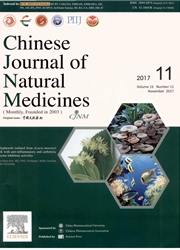

 中文摘要:
中文摘要:
目的:观察腺嘌呤对淋巴母细胞AHH-1辐射损伤的保护作用并探讨其作用机制。方法:照射前12h给予不同浓度的腺嘌呤,再经4.O Gy 60Coy射线照射诱发细胞凋亡,采用MTS法计算细胞存活率;Annexin V-FITC/PI双染法、Caspase3/7发光法检测细胞凋亡率;DNA Ladder法观察凋亡断裂条带;RT-PCR分析细胞Caspase-9、Bax、Bcl-2mRNA表达的变化。结果:与正常组比较,电离辐射后细胞存活率79.4%显著下降(P〈0.01,加入0.001,0.01,0.1μmol·L^-1。腺嘌呤细胞存活率分别为85.4%,89.6%,92.2%明显升高(P〈0.01),且随作用浓度的增加而增大,DNA断裂片段也减少,细胞中Caspase-9、Bax表达明显减少,Bcl-2表达明显增加,凋亡的各项指标均明显改善。结论:腺嘌呤对电离辐射诱发的细胞凋亡有保护作用,并且对细胞凋亡的抑制呈剂号依赖正相关美系.
 英文摘要:
英文摘要:
AIM: To investigate the radioprotective effect of adenine on irradiated lymphocytes and discover the possible mechanisms of protection. METHODS: Lymphocytes were pretreated for 12 h with adenine (0.001-0.1 pmol.L-1) and then exposed to 4 Gy radiation. Cell viability was observed by the MTS assay, apoptosis was detected by Annexin V-FITC/PI, DNA ladder, and caspase 3/7 activity. Caspase-9, Bax, and Bcl-2 gene expression was investigated by RT-PCR. RESULTS: Irradiation increased cell death and DNA fragmentation. Pretreatment with adenine significantly reversed this tendency. Furthermore, several anti-apoptotic characteristics of adenine were determined, including the ability to inhibit caspase 3/7, upregulate B-cell lymphoma (Bcl-2) and downregulate Bcl-2- associated X (Bax), capase-9 gene expression in 4 Gy-irradiated AHH-1 cells. CONCLUSION: The results suggest that adenine had a radioprotective effect to inhibit apoptosis in a concentration dependent manner.
 同期刊论文项目
同期刊论文项目
 同项目期刊论文
同项目期刊论文
 期刊信息
期刊信息
